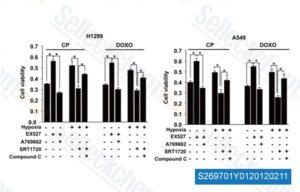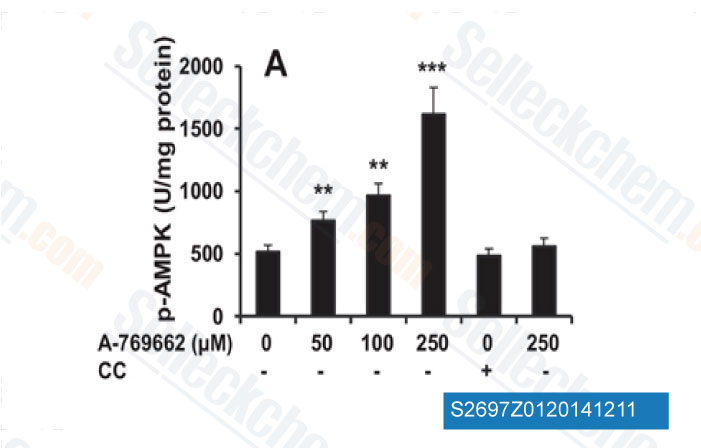|
Toll Free: (877) 796-6397 -- USA and Canada only -- |
Fax: +1-832-582-8590 Orders: +1-832-582-8158 |
Tech Support: +1-832-582-8158 Ext:3 Please provide your Order Number in the email. |
Technical Data
| Formula | C20H12N2O3S |
|||
| Molecular Weight | 360.39 | CAS No. | 844499-71-4 | |
| Solubility (25°C)* | In vitro | DMSO | 72 mg/mL (199.78 mM) | |
| Water | Insoluble | |||
| Ethanol | Insoluble | |||
|
* <1 mg/ml means slightly soluble or insoluble. * Please note that Selleck tests the solubility of all compounds in-house, and the actual solubility may differ slightly from published values. This is normal and is due to slight batch-to-batch variations. * Room temperature shipping (Stability testing shows this product can be shipped without any cooling measures.) |
||||
Preparing Stock Solutions
Biological Activity
| Description | A-769662 is a potent, reversible AMPK activator with EC50 of 0.8 μM in cell-free assays, little effect on GPPase/FBPase activity. | ||||
|---|---|---|---|---|---|
| Targets |
|
||||
| In vitro | A-769662 stimulates partially purified rat liver AMPK with EC50 with 0.8 μM. A-769662 activates AMPK purified from multiple tissues and species in a dose-responsive manner with modest variations in observed EC50s. EC50s determined for A-769662 using partially purified AMPK extracts from rat heart, rat muscle, or human embryonic kidney cells (HEKs) are 2.2 mM, 1.9 mM, or 1.1 mM, respectively. A 4 hours treatment of primary rat hepatocytes with A-769662 dose-dependently increases ACC phosphorylation, which correlated inhibition of fatty acid synthesis with IC50 of 3.2 μM. A-769662 also inhibits fatty acid sythesis in mouse hepatocytes with IC50 with 3.6 μM [1] A-769662 activates AMPK both allosterically and by inhibiting dephosphorylation of AMPK on Thr-172, similar to the effects of AMP. [2] A-769662 inhibits proteasomal function by an AMPK-independent mechanism. A-769662 affects the in vitro activity of purified 26S proteasomes but not the in vitro activity of purified 20S proteasomes. A-769662 has toxic effects on MEF cells. [3] A recent research shows A-769662 inhibited cell proliferation and DNA synthesis. [4] | ||||
| In vivo | Short-term treatment of normal Sprague Dawley rats with A-769662 decreases liver malonyl CoA levels and the respiratory exchange ratio, VCO2/VO2, indicating an increased rate of whole-body fatty acid oxidation. Treatment of ob/ob mice with 30 mg/kg b.i.d. A-769662 decreases hepatic expression of PEPCK, G6Pase, and FAS, lowers plasma glucose by 40%, reduced body weight gain and significantly decreases both plasma and liver triglyceride levels. [1] |
Protocol (from reference)
| Kinase Assay: |
|
|---|---|
| Cell Assay: |
|
| Animal Study: |
|
References
Customer Product Validation

-
Data from [Cancer Res, 2014, 74(1), 298-308]

-
Data from [Data independently produced by Pharmacol Res, 2014, 81, 34-43]

-
Data from [Data independently produced by J Lipid Res, 2014, 55(7), 1254-1266]

-
Data from [Data independently produced by Biochem Biophys Res Commun, 2013, 437(1), 1-6]
Selleck's A-769662 has been cited by 75 publications
| Hypoxanthine phosphoribosyl transferase 1 metabolizes temozolomide to activate AMPK for driving chemoresistance of glioblastomas [ Nat Commun, 2023, 14(1):5913] | PubMed: 37737247 |
| Hypoxanthine phosphoribosyl transferase 1 metabolizes temozolomide to activate AMPK for driving chemoresistance of glioblastomas [ Nat Commun, 2023, 14(1):5913] | PubMed: 37737247 |
| Pathogenesis-related protein 1 suppresses oomycete pathogen by targeting against AMPK kinase complex [ J Adv Res, 2023, 43:13-26] | PubMed: 36585103 |
| A subset of VEGFR-TKIs activates AMPK in LKB1-mutant lung cancer [ Cancer Sci, 2023, 114(4):1651-1662] | PubMed: 36459496 |
| Loss of Lactate/Proton Monocarboxylate Transporter 4 Induces Ferroptosis via the AMPK/ACC Pathway and Inhibition of Autophagy on Human Bladder Cancer 5637 Cell Line [ J Oncol, 2023, 2023:2830306] | PubMed: 36718218 |
| Discovery of a natural small-molecule AMP-activated kinase activator that alleviates nonalcoholic steatohepatitis [ Mar Life Sci Technol, 2023, 5(2):196-210] | PubMed: 37275542 |
| Identification of purine biosynthesis as an NADH-sensing pathway to mediate energy stress [ Nat Commun, 2022, 13(1):7031] | PubMed: 36396642 |
| AMPK regulates homeostasis of invasion and viability in trophoblasts by redirecting glucose metabolism: Implications for pre-eclampsia [ Cell Prolif, 2022, e13358.] | PubMed: 36480593 |
| Perfluorooctanoic acid alters the developmental trajectory of female germ cells and embryos in rodents and its potential mechanism [ Ecotoxicol Environ Saf, 2022, 236:113467] | PubMed: 35390687 |
| Akt/mTOR integrate energy metabolism with Wnt signal to influence wound epithelium growth inGekko Japonicus [ Communications Biology, 2022, 1018 (2022)] | PubMed: None |
RETURN POLICY
Selleck Chemical’s Unconditional Return Policy ensures a smooth online shopping experience for our customers. If you are in any way unsatisfied with your purchase, you may return any item(s) within 7 days of receiving it. In the event of product quality issues, either protocol related or product related problems, you may return any item(s) within 365 days from the original purchase date. Please follow the instructions below when returning products.
SHIPPING AND STORAGE
Selleck products are transported at room temperature. If you receive the product at room temperature, please rest assured, the Selleck Quality Inspection Department has conducted experiments to verify that the normal temperature placement of one month will not affect the biological activity of powder products. After collecting, please store the product according to the requirements described in the datasheet. Most Selleck products are stable under the recommended conditions.
NOT FOR HUMAN, VETERINARY DIAGNOSTIC OR THERAPEUTIC USE.
